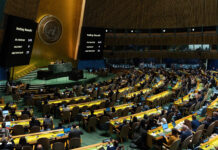Last month, during routine scanning of cargo at the Heathrow Airport, the British police came across a package with a “very small quantity of uranium”. The undeclared material was discovered on a passenger flight on 29 December. The Indian news agencies and Daily Mail Online reported January 10 “it was destined for an Iranian business with premises in the UK”
Being “not of weapon grade” the uranium was incapable of being used for improvising a “dirty bomb” (a radiation dispersal device). However, some news agencies and uncanny experts tried to whip up “dirty bomb” scare out of the incident. Hamish De Bretton-Gordon, former commander of the UK’s nuclear defence regiment lent credence to the unfounded scare. He said: ‘Uranium can give off very high levels of poisonous radiation. It could be used in a dirty bomb.’ Indian news agencies and the Daily Mail Online, in their reports, magnified “a very small quantity” into “several kilograms” of uranium. It was claimed that the package “originated” in Pakistan though it was headed for an Iranian business in Britain.
British Police Commander, Richard Smith clarified: ‘I want to reassure the public that the amount of contaminated material was extremely small and has been assessed by experts as posing no threat to the public. Although our investigation remains ongoing, from our inquiries so far, it does not appear to be linked to any direct threat.
‘As the public would expect, however, we will continue to follow up on all available lines of enquiry to ensure this is definitely the case.
‘However, it does highlight the excellent capability we and our partners have in place to monitor our ports and borders in order to keep the public safe from any potential threats to their safety and security that might be coming into the UK.’ ‘The material has been identified as being contaminated with uranium.’
India’s own record is dismal. Let us recall a few incidents.
The Heathrow nuclear material is now seen as ‘deadly’ but the UK-based media agency reported that the uranium was ‘not weapons-grade’ – and so could not be used to manufacture a thermo-nuclear weapon. It appears that “dirty bomb” is a hoax to exploit nouveau-nuclear or nuclear-threshold nations. It could be a weapon of mass disruption, but not a weapon of mass destruction. Real threat emanates from chemical or bio-weapons.
India has a sprawling civil and military nuclear programme that spreads over several states. In an article in The Diplomat, Sitara Noor highlighted shortcomings in the safety and security of India’s nuclear facilities In India’s radio-active bazaar: Recurring incidents involving theft and sale of nuclear materials demonstrate why India must develop an independent nuclear regulatory body, she said: ‘While global markets are taking a dip due to economic recession, India’s illicit uranium market seems to be flourishing. In February, eight people including two Indian officials were apprehended in Nepal for illegally possessing and attempting to sell “uranium-like substance”. The material was reportedly smuggled from India. This was not just a one-off incident— theft and sale of nuclear and radioactive material in India is a recurring phenomenon. Earlier in May 2021, reports of the seizure of 7 kilograms of highly radio-active uranium worth 210 million Indian rupees from a scrap dealer raised serious concern about India’s nuclear security capabilities. Over the past two decades over 200 kilograms of nuclear and radio-active materials has reportedly disappeared from Indian facilities. Frequent incidents of loss and theft of nuclear and radio-active materials in India indicate the failure of the nuclear security systems at multiple levels. First there seems to be a gap in the material accounting and control systems to ensure that not even an iota of material is left unaccounted. Second, the nature of incidents in India hints at the involvement of insiders— someone working at the nuclear facilities or mining sites working independently or colluding with an outsider. This indicates the serious risk of insider threat and a failure of personnel reliability program. Third, the recurrence of nuclear security lapses with such impunity indicates serious issues with nuclear security culture in India…’
It is much easier and cheaper to make a chemical or biological bomb than a “dirty bomb” (It is believed that the chemical bombs used by Saddam’s Iraq against Iran were made with Indian know-how). Though a “dirty bomb” has never been used by any “terrorist”, a bio/chemical bomb was actually used by Japan’s former doomsday-cult Guru Shoko Asahara. The Guru stands sentenced to death “for masterminding the deadly 1995 nerve/chemical gas (sarin) attack on the Tokyo subway and a string of other crimes that killed 27 people”.
The cult’s quest for biological weapons was overshadowed by its chemical attack capability. The cult members were trying to develop botulinum toxin by utilizing toxin of the green mamba snake and poisonous mushroom spores,
Regarding use of chemical/biological weapons by “terrorists”, Professor Ramesh Chandra points out in his Global Terrorism, “The US government indicates that these weapons are well within the reach of terrorists. According to the Central Intelligence Agency, ‘Terrorist interest in chemical and biological weapons is not surprising, given the relative ease with which some of these weapons can be produced in simple laboratories… Although popular fiction and national attention have focused on terrorist use of nuclear weapons, chemical and biological weapons are more likely choices for such groups’”.
Not only sarin, but also several other chemical agents like mustard, tabun, soman and VX are capable of dual use as pesticides and as chemical weapons. Chandra points out, “chemical warfare agents ‘can quite literally be manufactured in a kitchen or basement in quantities sufficient for mass-casualty attacks”. Experts agree that it is more difficult to manufacture Sarin gas, used by the “terrorists” in Japan, than mustard, tabun, soman, et al. To some experts, an effective bio-terrorism facility could be built for $ 200,000 to $2 million.
Biological weapons, too, are easier to manufacture than “dirty bombs”. Viruses could cause smallpox, Venezuelan equine encephalitis and hemorrhagic fevers like Ebola. The threat of biological weapons is obvious from the fact that: (1) The charges for anthrax, Q fever (Coxiella burnetti) and Venezuelian equine encephalomyeletus cultures from a leading US culture collection are about $45, $80, and $81 respectively. Besides, nature abounds with microscopic killers. Bacillus anthracis resides in hides and carcasses of wild or domesticated animals and plagues in prairie dogs, chipmunks, black rats, deer mouse and coyotes. Chandra states that “The cost estimates for a bio-terrorism facility vary quite widely from $200,000 to $2 million…Instructions for how to mass produce, purify, and concentrate microbes can be found in textbooks and scientific journals”.
The Heathrow nuclear material is now seen as ‘deadly’ but the UK-based media agency reported that the uranium was ‘not weapons-grade’ – and so could not be used to manufacture a thermo-nuclear weapon. It appears that “dirty bomb” is a hoax to exploit nouveau-nuclear or nuclear-threshold nations. It could be a weapon of mass disruption, but not a weapon of mass destruction. Real threat emanates from chemical or bio-weapons.






















